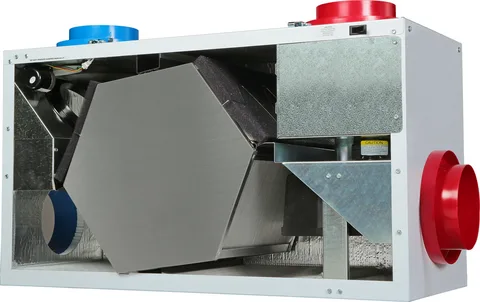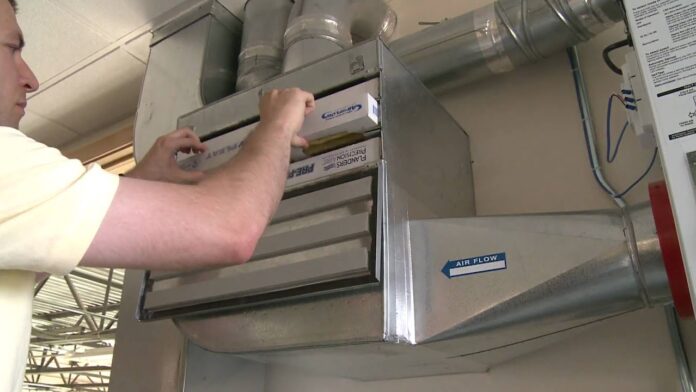As homeowners, we all strive for a comfortable and healthy living environment. And a crucial aspect of achieving that is proper ventilation. This is where Residential Air to Air Heat Exchanger come into play. These innovative devices have revolutionized the way we exchange air in our homes, providing an elegant and efficient solution to maintain indoor air quality. In this blog post, we will delve into the world of residential heat exchangers and discover how they work to keep our homes comfortable and healthy.
Unpacking the Basics: What is a Residential Heat Exchanger?
A residential heat exchanger is a device that is used to transfer heat from one area to another within a home. It is designed to improve the air quality and overall comfort of a living space by efficiently exchanging stale indoor air with fresh outdoor air.
So how does it work? A residential heat exchanger consists of two separate air streams that flow through the device. These air streams are kept separate from each other, ensuring that the fresh air entering the home does not mix with the stale air being expelled.
The heat exchanger utilizes a heat recovery core, which allows for the transfer of heat between the incoming and outgoing air streams. In winter, the warm indoor air passes through the core, transferring its heat to the colder incoming air. This helps to preheat the fresh air before it enters the living space, reducing the need for excessive heating and saving energy.
In the summer, the process is reversed. The cool indoor air passes through the core, cooling the warmer incoming air before it enters the home. This helps to maintain a comfortable temperature and reduces the load on air conditioning systems.
Overall, a residential heat exchanger is a valuable addition to any home, providing energy-efficient ventilation and improved air quality. It ensures that our homes remain comfortable and healthy throughout the year.
Home Air Heat Exchanger
When it comes to maintaining a comfortable and healthy living environment, a Home Air Heat Exchanger is a game-changer. This innovative device is designed to improve indoor air quality by efficiently exchanging stale indoor air with fresh outdoor air. But what exactly is a Home Air-Heat Exchanger?
Simply put, a Home Air-Heat Exchanger is a system that allows for the transfer of heat between two separate air streams within your home. It ensures that the fresh air entering your home does not mix with the stale air being expelled, creating a healthy and comfortable living space.
During the winter months, the warm indoor air passes through the heat recovery core of the heat exchanger, transferring its heat to the colder incoming air. This preheats the fresh air, reducing the need for excessive heating and saving energy. In the summer, the process is reversed, with the cool indoor air cooling the warmer incoming air.
A Home Air-Heat Exchanger is an essential component of a well-ventilated home, providing energy-efficient ventilation and improved air quality. Say goodbye to stale air and hello to fresh, clean air with a Home Air-Heat Exchanger.
Heat Recovery Air Exchanger
One of the key players in the world of residential heat exchangers is the heat recovery air exchanger. This device takes the principles of heat exchange to a whole new level, providing an even more efficient way to improve air quality and maintain a comfortable living environment.
So, how does a heat recovery air exchanger work? Well, it operates by using a heat recovery core to transfer heat between the incoming and outgoing air streams. But what sets it apart from other residential heat exchangers is its ability to not only transfer heat but also moisture. This means that during the colder months, when the indoor air is dry, the heat recovery air exchanger can help to add moisture to the incoming air, preventing dryness and discomfort.
With its advanced heat and moisture transfer capabilities, the heat recovery air exchanger is a must-have for any homeowner looking to optimize their indoor air quality and comfort. It’s a true game-changer in the world of residential ventilation, providing a sophisticated and efficient solution for maintaining a healthy and comfortable living space.
Heat Recovery Exchanger
The Heat Recovery Exchanger is a true game-changer when it comes to residential heat exchangers. This innovative device takes the principles of heat exchange to a whole new level, providing an even more efficient way to improve air quality and maintain a comfortable living environment. But what sets it apart from other heat exchangers?
Well, the Heat Recovery-Exchanger not only transfers heat between the incoming and outgoing air streams but also has the ability to transfer moisture. This means that during the colder months, when the indoor air tends to be dry, the Heat Recovery-Exchanger can help add moisture to the incoming air, preventing dryness and discomfort.
With its advanced heat and moisture transfer capabilities, the Heat Recovery-Exchanger is a must-have for any homeowner looking to optimize their indoor air quality and comfort. It truly takes ventilation to a whole new level, providing a sophisticated and efficient solution for maintaining a healthy and comfortable living space. Say goodbye to stale air and hello to fresh, clean air with the Heat Recovery-Exchanger.
 Residential Energy Recovery Ventilator
Residential Energy Recovery Ventilator
The Residential Energy Recovery Ventilator (ERV) is a cutting-edge device that takes ventilation to a whole new level. With its advanced technology, this innovative system is designed to not only exchange stale indoor air with fresh outdoor air but also recover energy in the process.
So, how does the Residential ERV work? Well, it operates by utilizing a heat exchanger core to transfer both heat and moisture between the incoming and outgoing air streams. This means that during the colder months, the ERV can help to preheat the fresh air while also adding moisture to prevent dryness and discomfort. Similarly, in the summer, it can remove excess humidity from the incoming air, creating a more comfortable indoor environment.
The beauty of the Residential ERV lies in its ability to save energy. By recovering and transferring both heat and moisture, it reduces the need for excessive heating or cooling, ultimately leading to lower energy bills.
Overall, the Residential ERV is a game-changer in the world of residential ventilation. It offers homeowners an elegant and efficient solution to maintain indoor air quality, energy efficiency, and overall comfort. With this revolutionary device, you can say goodbye to stale air and hello to a healthier, more comfortable living space.
Residential Heat Recovery Systems
Residential heat recovery systems are a vital component of a well-designed ventilation system. These systems are specifically designed to recover and reuse the heat that is typically lost during the process of exchanging indoor and outdoor air. By capturing and recycling this heat, residential heat recovery systems can significantly reduce energy consumption and lower heating costs.
There are different types of residential heat recovery systems available, including heat recovery ventilators (HRVs) and energy recovery ventilators (ERVs). HRVs are designed to transfer heat from the outgoing stale air to the incoming fresh air, while ERVs go a step further by also transferring moisture. This means that not only do ERVs recover heat, but they also help to control humidity levels within the home.
With the help of a residential heat recovery system, homeowners can enjoy fresh, clean air while minimizing energy waste. These systems not only contribute to a comfortable and healthy living environment but also reduce the overall carbon footprint of a home. So, if you’re looking to optimize your ventilation system and save energy, investing in a residential heat recovery system is definitely worth considering.
Residential Heat Recovery Ventilator
The Residential Heat Recovery Ventilator (HRV) is a game-changer when it comes to ventilation in residential homes. This innovative device combines air exchange with energy recovery, providing homeowners with an efficient and sustainable solution to improve indoor air quality while reducing energy consumption.
How does the Residential HRV work? Well, it operates by using a heat exchanger core to transfer both heat and moisture between the incoming and outgoing air streams. This means that during the colder months, the HRV can help preheat the fresh air while also adding moisture to prevent dryness and discomfort. In the summer, it can remove excess humidity from the incoming air, creating a more comfortable indoor environment.
What sets the Residential HRV apart is its ability to recover and reuse heat energy that is typically lost during the ventilation process. By capturing and recycling this heat, the HRV significantly reduces the need for excessive heating and cooling, ultimately leading to lower energy bills.
With the Residential Heat Recovery Ventilator, you can enjoy fresh, clean air and a more energy-efficient home. Say goodbye to stale air and hello to a healthier and more comfortable living space.
FAQs
Got questions about residential heat exchangers? We’ve got answers! Check out our FAQ section below to learn more about these innovative devices and how they can improve your home’s comfort and air quality.
- What are the benefits of a residential heat exchanger?
A residential heat exchanger offers several benefits. It improves indoor air quality by exchanging stale indoor air with fresh outdoor air. It also helps maintain a comfortable temperature by preheating or cooling the incoming air, reducing the load on your heating or cooling system. Additionally, a heat exchanger can save energy and lower your utility bills.
- How long do residential heat exchangers last?
The lifespan of a residential heat exchanger can vary depending on factors such as usage, maintenance, and quality of the unit. However, on average, a well-maintained heat exchanger can last between 10 and 20 years.
- Can I install a residential heat exchanger myself?
While it’s possible to install a residential heat exchanger yourself, it’s recommended to hire a professional for installation. A professional can ensure proper sizing, placement, and connection to your existing HVAC system.
- How often should I clean or replace the filters in my heat exchanger?
The frequency of filter cleaning or replacement depends on the manufacturer’s recommendations and the air quality in your home. In general, it’s a good idea to check and clean or replace the filters every three to six months.
Conclusion
In conclusion, residential heat exchangers are a game-changer when it comes to maintaining a comfortable and healthy living environment. With their ability to efficiently exchange air and recover heat and moisture, these devices offer an elegant and efficient solution for optimizing indoor air quality and energy efficiency in our homes. Say goodbye to stale air and hello to a healthier, more comfortable living space with a residential heat exchanger.

